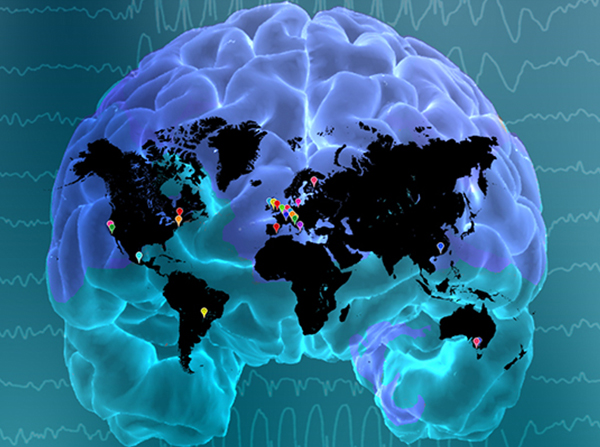
The ENIGMA consortium unites researchers in 37 countries to study 22 different brain diseases, often pooling data from more than 20,000 subjects. (Image/Courtesy ENIGMA)
Epilepsies, a group of disorders known to vary greatly in their causes and symptoms, share key structural foundations in the brain, according to a new big data neuroimaging collaboration involving researchers from the USC Mark and Mary Stevens Neuroimaging and Informatics Institute (INI) at the Keck School of Medicine of USC. Epilepsy and seizure disorders affect at least 5.1 million Americans, according to the Centers for Disease Control and Prevention.
“Our study shows that although epilepsy is a highly heterogeneous disorder with dozens of different causes, presentations and treatments, multiple common forms of epilepsy do share similar neuroanatomical underpinnings,” said Christopher Whelan, PhD, lead author of the study, who was based at INI’s Imaging Genetics Center when the study was conducted. “Brain structures like the thalamus and the motor cortex are implicated across a diverse range of epilepsy subtypes, despite the vast heterogeneity of their clinical presentations.”
The study, which will be published in the February issue of Brain, is part of the INI’s Enhancing Neuro Imaging Genetics Through Meta-Analysis (ENIGMA) consortium, which unites researchers from around the world to pool data on brain diseases. The present analysis combines data from 24 research centers in 14 countries across Europe, North and South America, Asia and Australia. Brain scans of 2,149 epilepsy patients and 1,727 matched controls were assessed to better understand patterns of brain differences in one of the largest epilepsy imaging studies ever conducted.
“There has never before been an investigation of this magnitude comparing the different types of epilepsy,” said Neda Jahanshad, PhD, assistant professor of neurology at the Keck School of Medicine of USC and co-author of the study. “The sheer scale of the collaboration allows us to try and answer some of the more difficult questions about the disorder with more confidence.”
Taking a broad view of the brain, the researchers conducted a massive meta-analysis comparing 84 brain regions between epilepsy patients and controls. They found structural patterns suggesting key similarities, as well as equally salient differences, between various forms of the disease, including generalized epilepsies, mesial temporal lobe epilepsies and others.
“Taken together, it’s notable that the thalamus, a central sensory relay region, and the precentral gyrus, which is the brain’s primary motor region, both show consistent abnormalities across all the various types of epilepsies in our studies,” said Whelan, who is now manager of human genetics at Pfizer Worldwide Research and Development in Cambridge, Massachusetts. “This may offer a biological basis for the sudden falls, the involuntary movements and the losses of consciousness often experienced by people with epilepsy.”
The findings indicate that there may be a quantifiable biological basis for these symptoms. “It opens up the possibility that we’re able to find shared mechanisms that might be amenable to treatment,” said Sanjay Sisodiya, PhD, FRCP, professor of neurology at University College London and the study’s senior author.
Sisodiya cautions that the observed effects are numerically modest, and more research is needed to determine whether the patterns identified here are themselves responsible for epilepsy or a byproduct of the disease.
“This is currently a cross-sectional study — not a longitudinal study. That has a number of implications: for example, we cannot yet determine what is cause and what is effect,” Sisodiya said.
The ENIGMA Epilepsy team is currently coordinating a follow-up study comparing connectivity in the brains of epilepsy patients with controls. While the present study looked at the gray matter of the brain’s cell bodies, the new investigation will analyze white matter — the projections that connect many of the brain’s regions together.
Other consortium members will use the pooled data for additional new research. Some are applying machine learning to predict the focal point of seizure onset in the brain. Others are using advanced algorithms to characterize patterns of gene co-expression associated with neural network changes in epilepsy.
INI’s Jahanshad says a target area for future research is to understand the neuroanatomic underpinnings of drug treatment and why some patients respond to anti-epileptic medications while others do not.
“Once we have enough groups participating that have collected medication response information on existing patients, we may be able to see if a certain brain signature exists,” she said. This could ultimately help personalize treatment for patients.
At USC, researchers across disciplines are seeking to prevent or treat neurological and psychiatric disorders including epilepsy and Alzheimer’s disease. ENIGMA alone has published some of the largest neuroimaging studies of autism, major depression and bipolar disorder.
With over 100 clinicians, neuroscientists and bioinformaticians on five continents already involved in the ENIGMA Epilepsy initiative, the researchers are optimistic about what the future may hold.
“Our hope is that the study has laid a foundation for meaningful new discoveries and has helped build lasting relationships that will allow us to combine our resources and address scientific questions with greater power than we could have done before,” Whelan said.
— Zara Abrams